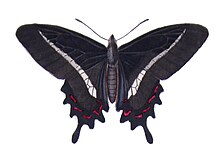| Parides bunichus | |
|---|---|

| |
| P. b. damocrates, male | |

| |
| P. b. chamissonia | |
| Scientific classification | |
| Domain: | Eukaryota |
| Kingdom: | Animalia |
| Phylum: | Arthropoda |
| Class: | Insecta |
| Order: | Lepidoptera |
| Family: | Papilionidae |
| Genus: | Parides |
| Species: | P. bunichus
|
| Binomial name | |
| Parides bunichus | |
| Synonyms | |
| |
Parides bunichus is a butterfly of the family Papilionidae. It is found in Brazil, Paraguay, Argentina and Uruguay.
The larva is brownish black, with an oblique white band, extending laterally from the 6th segment to the tubercle on the 7th. The pupal stage lasts three weeks.
The butterfly is very common and is one of the earliest spring species (August). From August to April there are at least three generations.
